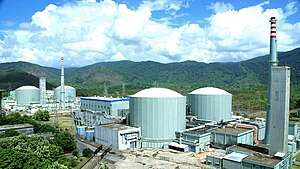| Kaiga Generating Station | |
|---|---|
 | |
 | |
| Country | India |
| Coordinates | 14°51′55.16″N 74°26′22.71″E / 14.8653222°N 74.4396417°E |
| Status | Operational |
| Construction began | 1989 |
| Commission date | 16 November 2000 |
| Owner(s) | NPCIL |
| Operator(s) | NPCIL |
| Nuclear power station | |
| Reactors | 4 |
| Reactor type | Units 1,2,3 & 4: IPHWR-220 Units 5 & 6: IPHWR-700 |
| Reactor supplier | NPCIL/BARC |
| Cooling source | Kadra Dam, Kali River |
| Power generation | |
| Units operational | 4 x 220 MW |
| Nameplate capacity | 880 MW |
| Capacity factor | 92.02% (2020-21)[1] |
| Annual net output | 7094 GW.h (2020-21)[1] |
| External links | |
| Website | www |
Kaiga Generating Station is a nuclear power generating station situated at Kaiga, near the river Kali, in Uttara Kannada district of Karnataka, India. The plant has been in operation since March 2000 and is operated by the Nuclear Power Corporation of India.
It has four units. The fourth unit went critical on 27 November 2010.[2] The two oldest units comprise the west half of the site and the two newer units are adjoining the east side of the site. The older four units are small-sized pressurized heavy water reactors of 220 MW gross.